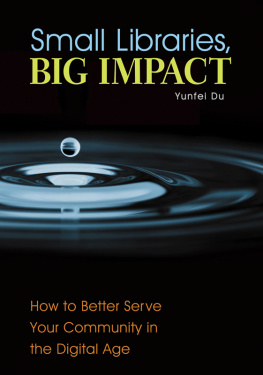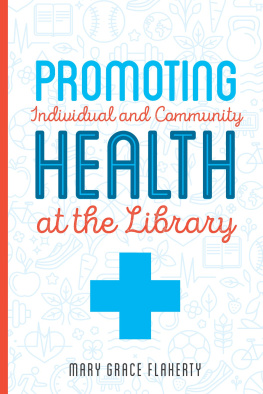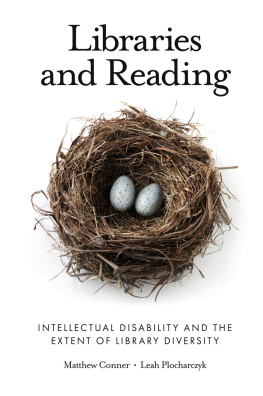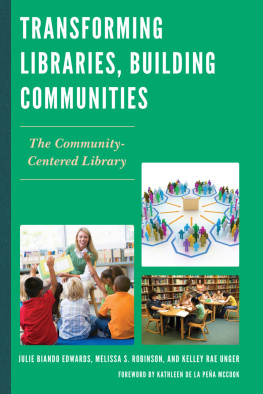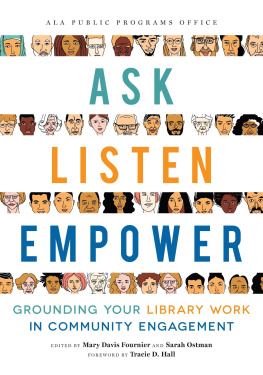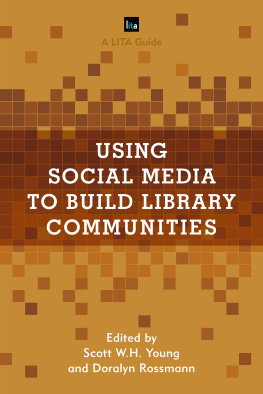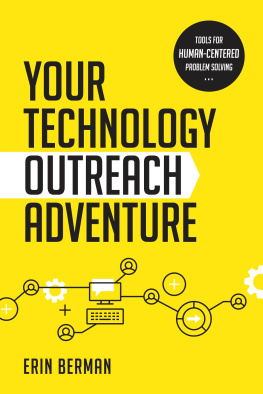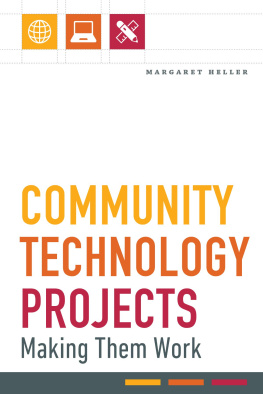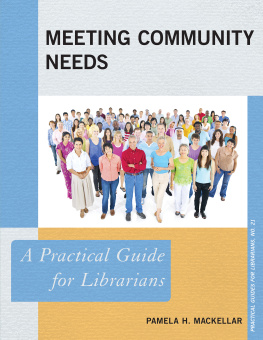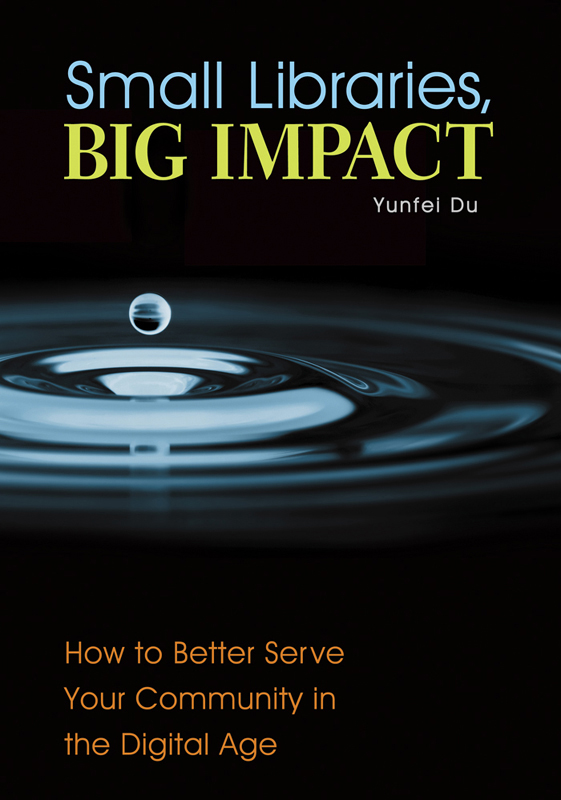Small Libraries, Big Impact
Copyright 2016 by Yunfei Du
All rights reserved. No part of this publication may be reproduced, stored in a retrieval system, or transmitted, in any form or by any means, electronic, mechanical, photocopying, recording, or otherwise, except for the inclusion of brief quotations in a review, without prior permission in writing from the publisher.
Library of Congress Cataloging-in-Publication Data
Names: Du, Yunfei, 1970- author.
Title: Small libraries, big impact : how to better serve your community in the digital age / Yunfei Du.
Description: Santa Barbara, CA : Libraries Unlimited, [2016] | Includes bibliographical references and index.
Identifiers: LCCN 2015049681 (print) | LCCN 2016017929 (ebook) | ISBN 9781440841569 (paperback) | ISBN 9781440841576 (ebook)
Subjects: LCSH: Libraries and communityUnited States. | Library outreach programsUnited States. | Public librariesSocial aspectsUnited States. | Small librariesUnited StatesCase studies. | Rural librariesUnited StatesCase studies.
Classification: LCC Z716.4 .D82 2016 (print) | LCC Z716.4 (ebook) | DDC 027.473dc23
LC record available at https://lccn.loc.gov/2015049681
ISBN:978-1-4408-4156-9
EISBN: 978-1-4408-4157-6
201918171612345
This book is also available on the World Wide Web as an eBook.
Visit www.abc-clio.com for details.
Libraries Unlimited
An Imprint of ABC-CLIO, LLC
ABC-CLIO, LLC
130 Cremona Drive, P.O. Box 1911
Santa Barbara, California 93116-1911
This book is printed on acid-free paper 
Manufactured in the United States of America
CONTENTS
Public libraries in the United States are indispensable institutions. There are more public libraries in the United States than there are McDonalds restaurants16,604 library service outlets compared with 14,339 McDonalds restaurants (Columbus Public Library, 2015). In the past decade, two-thirds of Americans annually visited a public library at least once, and 62% of adults in the United States had public library cards (American Library Association, 2015a). In 2012, there were 1.5 billion in-person visits to public libraries across the United Statesa 10-year increase of 20.7% (American Library Association, 2015b). And Americans love their libraries: according to a recent Pew Research Center report, 90% of Americans ages 16 and older say that the closing of their local public library would have an adverse impact on their community (Pew Research Center, 2014). These statistics state the obvious: the American public library is a heavily used and ubiquitous institution.
The 16,536 public library outlets in the United States are administered by 9,041 separate library systems. Of these systems, 7,321or 80%are single outlet libraries (American Library Association, 2015a). These libraries primarily serve small and rural communities. Because 80% of public library systems serve towns with populations less than 25,000, this is especially true in small town America. Rare is the small town without a public library. In the past century, thousands of small public libraries have circulated billions of books to citizens. More important, they have also served as destinations, places where citizens can go to learn, to become informed, and to create community.
In his book Main Street Public Library, historian Wayne A. Wiegand demonstrated the impact that small town public libraries have on their communities. Wiegand documented that the primary purpose and mission of small town libraries was to foster the kinds of social harmony that community spaces and storiesexperienced and sharedprovide (Wiegand, 2011, p. 186). Main Street Libraries served primarily as a civic space for the creation of social cohesion and reinforcement of local values and taste, defining for each community what Wiegand terms a uniquely negotiated cultural center (Wiegand, 2011, p. 183).
But as Professor Du demonstrates in detail in the pages that follow, rural libraries face significant challenges. They are small and often isolated, and they compete for a limited pool of local resources. Funding for rural libraries is overwhelmingly local: four-fifths of all rural public library expenditures come from local sources, primarily local ad-valorem and sales tax revenue. To secure operating resources, rural public libraries must compete with other highly valued services, including police and fire protection, public schools, and even sanitation.
Urban Libraries Council (2011, p. 1) suggested the importance of public libraries providing highly valued services to communities:
Research and experience demonstrate that engaged and empowered citizens generate optimism about the future, produce good decisions on tough community challenges, and contribute to economic success and individual well-being. Public libraries, with their sustained stature as the most trusted government entity, are ideal resources to shape and lead discussions, decisions, and strategies that encourage active and purposeful civic engagement. Yet, despite the assets, resources, and experience that libraries bring to the table, they are rarely seen as community and civic engagement leaders.
Too often libraries are viewed by local government officials and resource allocators as nice things to have when we can afford them. Failing to leverage the librarys broad community connections, respected public stature, and capacity to bring people together is a missed opportunity (Urban Libraries Council, 2011, p. 1).
To help address this situation, and empower one segment of the rural public library sector, in 2010, the University of North Texass College of Information initiated a three-year project, funded by a $1.6 million grant from the Robert and Ruby Priddy Charitable Trust. The project was given the name Promoting & Enhancing the Advancement of Rural Libraries (PEARL) (University of North Texas, 2010). The PEARL project was designed to strengthen the public library as an essential part of community life in rural communities in Texas. The idea behind the PEARL project was to change the perception of libraries, from role players to valued leaders in todays civic engagement space, and achieve recognition of the public library as an essential service, just like the police and fire departments and the local schools (Blake, Martin, & Du, 2011, p. 2).
The purpose of the project was not to try to tell the participants what to do, or to invent their library services program from scratch. Most of the librarians in small and rural communities are very capable. They have deep roots in their communities. They generally know the people, their needs and concerns, and the issues that command attention. They already provide important resources and services. The purpose of the PEARL project was to assist them in strengthening their ability to demonstrate the value of the library and develop partners in the community. The approach was to provide them with a set of tools and a process to achieve that end. Ultimately, we expected to help them change the public perception of the library in the community from a nicety to a necessity.
The success of the PEARL project underscores that the approach we took can be extended more generally to all public libraries. The underlying principle of our approach was the necessity to demonstrate public value. Library public value is determined by users.
In a sense, really, this is a no-brainer: if public enterprises do not create value for the public, then why would they be formed or continue to exist? The problem, of course, is how do you define and measure public value?

